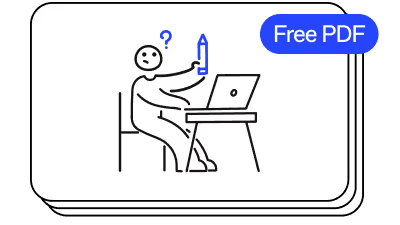Boosting performance through feedback and follow-through
.avif)
Discover Workleap Officevibe's benchmark report on 12 key employee engagement metrics

Many employees fear performance reviews. With rushed conversations, vague phrases, and outdated performance management rituals being pretty common, it’s easy to see why. But when reviews and feedback sessions are done well, they boost performance, workplace culture, employee growth, and your bottom line.
Performance and feedback go hand in hand, but what does great critique actually look like? In this guide, we break down best practices and offer some example performance review phrases for you to try.
What is performance feedback?
Performance feedback is a key part of performance management. It keeps managers and employees aligned on expectations and progress. Feedback gives people a clear view of what they’re doing well, where they can improve, and how their work contributes to team and company goals.
When delivered consistently and constructively, performance feedback builds trust, supports accountability, and helps employees take ownership of their development. “Consistently and constructively” are key — knowing what feedback is is one thing, but knowing how to give it well is what makes it effective.
How to give employee feedback: 5 key elements
Whether you’re prepping feedback for performance reviews or having a quick 1:1, remembering these five elements will make your message more impactful.
1. Get specific
The more targeted you are with your feedback, the better. Criticism that’s too vague often feels personal. But if you call out specific incidents and behavior patterns, it helps employees see precisely where to focus.
2. Give it frequently
Delivering performance feedback too infrequently risks employees not seeing the relevance of your advice. Instead of solely relying on annual performance reviews, encourage managers to offer guidance to their reports frequently throughout the year. If you’re calling out a specific incident, try to offer feedback as close to the event as possible.
3. Offer guidance on how to improve
To be effective, performance feedback needs to offer a route toward success. Rather than just criticizing your employee’s performance, offer suggestions on how they can improve. This provides them with direction, helping success feel more realistic and achievable.
4. Aim for balance
Focusing solely on the negative can make reviews and feedback sessions feel like reprimand. When you point out an employee’s strengths and combine this with constructive criticism, they won’t feel judged or attacked.
5. Align with the bigger picture
Tie every piece of feedback back to the individual’s personal and career growth and your organization’s goals. For example, if someone is struggling with time management, discuss the importance of meeting deadlines to be considered for promotion. Then, highlight how poor timekeeping affects their team. This approach helps employees see the relevance of your feedback and advice.
Workleap Performance makes it easier for managers and HR leaders to put these principles into action. It helps them set clear goals, track progress, and align feedback with employee development and business objectives.
Effective performance feedback examples
Here are a few example performance review phrases for you to use as a starting point.
Giving constructive feedback examples
This type of actionable, performance-focused feedback is useful for employee evaluations. Example phrases include:
Example: “Your slide deck covered all the facts. Next time, you could try opening with a light anecdote or story to grab their attention.”
Why it works: This feedback is specific and kind. It calls out a strength and provides a realistic next step.
Example: “I noticed you submitted your report one day after the deadline. Let’s plan an earlier check-in next week so we can stay ahead.”
Why it works: By focusing on a concrete action rather than assigning blame, you encourage accountability without the employee feeling attacked.
Example: “When you interrupted your colleague during the brainstorming session, it disrupted the flow. Try pausing before jumping in to make sure they’ve finished their point. It’ll help the team work better together.”
Why it works: Constructive feedback that focuses on specific employee behavior helps them see the impact of their actions.
Positive reinforcement examples
Recognizing employees’ achievements motivates them to keep up the good work. Done right, this type of feedback boosts confidence and drives engagement. Examples include:
Example: “You consistently met your goals ahead of schedule. Your great work kept our projects running smoothly.”
Why it works: This feedback acknowledges the employee’s achievement and connects it to business outcomes, helping them see the impact of their efforts.
Example: “Your willingness to help your team members has boosted the group’s morale and collaboration.”
Why it works: When you praise specific behaviors that contribute to the bigger picture, you reinforce a sense of shared success.
Example: “The initiative you’ve taken on the new automation project shows great ownership and leadership potential.”
Why it works: Connecting feedback to an employee’s growth motivates them to keep working to a high standard.
Developmental feedback examples
Developmental feedback helps people reach their full potential by focusing on long-term growth and skill-building. Some useful phrases include:
Example: “You nailed the technical side of this project. Next, let’s focus on improving your time management skills so you can lead more cross-functional work.”
Why it works: This performance review phrasing starts with recognition, then suggests a growth area to keep things balanced.
Example: “Your weekly check-ins are strong. Let’s start adding three action items so your reports leave their meetings knowing what comes next.”
Why it works: Giving feedback like this highlights your employee’s strengths while adding structure. The result? Consistent progress.
Example: “You communicate well with the team. Let’s build on that by practicing delivering constructive criticism when things need a reset.”
Why it works: Feedback can be a great opportunity to highlight a specific skill an employee could work on.
Team collaboration feedback examples
This type of feedback highlights how well someone works with others. Teamwork, communication, and mutual accountability are all key ingredients for a healthy workplace. Some examples might be:
Example: “I appreciate you stepping in to help a teammate who was behind on their project. It helped keep everyone on track.”
Why it works: Giving feedback in this way celebrates proactive teamwork and encourages strong communication.
Example: “It’s great that you made space for everyone’s ideas in the design review. Let’s build those skills by you leading the next cross-team workshop.”
Why it works: This feedback connects your employee’s collaboration skills to their leadership development. It helps them see how teamwork can lead to growth opportunities.
Example: “When you shared customer insights in the chat, it kicked off a productive conversation. Let’s pull out two takeaways and turn them into an action plan.”
Why it works: Performance feedback like this reinforces a company culture of follow-through and accountability.
Leadership skills feedback examples
This performance feedback helps your employees move from doing great work to inspiring others to do the same. Example phrases include:
Example: “The performance review you carried out showed structure and empathy. Next time, ask the employee what challenges they’re facing and suggest steps for solving them.”
Why it works: This performance feedback highlights what went well and adds a clear next step. It offers the manager a way to elevate their coaching skills.
Example: “You took ownership of the product launch and guided the team with impressive confidence. Do you want to mentor a new team member to share your expertise?”
Why it works: Giving feedback in this way reinforces positive behavior by providing a growth opportunity. It connects your employee’s recent success to their leadership development.
Example: “You challenged the team to rethink our approach. That sparked great ideas. Let’s schedule a follow-up to track how those ideas play out.”
Why it works: When you praise critical thinking and link it to measurable results, you encourage employees to think about the company-wide impact of their efforts.
Bring performance feedback to life with Workleap
Consistent, actionable feedback improves employee performance while also driving engagement and helping contribute to their development. Workleap tools can help you deliver effective feedback that’ll keep your employees working at their best.
Workleap Officevibe allows you to collect continuous feedback from employees so you can spot trends before they turn into trouble. Workleap Performance is your go-to tool for monitoring your team’s progress toward their goals. Together, they make it easy for managers to offer feedback and advice that sticks.
Ready to make every performance review and check-in count? Try Workleap for free today.
Addressing poor performance template


%20(1).avif)


.avif)
.avif)








%202.avif)